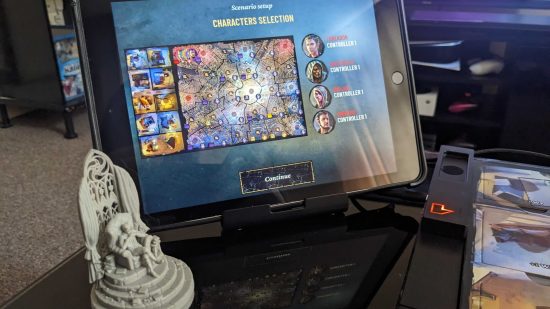Vampire: The Masquerade – Milan Uprising is a crossover between the beloved World of Darkness universe and the smart technology of Teburu. Its goal? To automate the clunkier parts of a sprawling strategy board game so we can focus on the rich writing of a VtM campaign. Unfortunately, from my early Vampire: The Masquerade – Milan Uprising preview, it seems there’s plenty of crossed wires in this crossover.
Before we begin exploring Milan, I’d like to mention this preview copy was provided by Xplored. I’d also like to point out this is a very limited sneak peek – the preview copy of Milan Uprising only allowed me to play two full rounds, and I was playing with a prototype version of Teburu that’ll be updated before the full release. Basically, the term ‘first impression’ applies very hard here.

What is Vampire the Masquerade: Milan Uprising?
Crowdfunding on Gamefound until August 25, Vampire: The Masquerade – Milan Uprising is a story-driven co-op board game set in the world of the VtM tabletop RPG. You’ll control a group of Anarchs, young upstart vampires looking to defy their elders and gain autonomy. In a 25+ hour campaign, you’ll explore the city, completing story missions to expand your terrain, leveling up your characters’ skills, and defending against enemies (human and vampire) to maintain power.
Milan Uprising is exclusively available on the Teburu system. This is a piece of smart tech that automates aspects of playing a board game and retains data from your campaign. Teburu eliminates analogue rulebooks and dice, and it can ‘save your game’ to keep story and character progression in place for your next playthrough. Players can use a mobile device or tablet to run the game’s app while they play with its physical components.
Thoughts on the Teburu system
‘Cumbersome’ is the first word Teburu brings to mind. The features it adds to Milan Uprising don’t seem worth the investment required – in terms of time, battery life, and the extra $100 you’ll need to spend.
Teburu drags out actions and calculations the human brain can manage in a few seconds. You can’t simply move a miniature to your desired location and calculate the action points it’d take to get there – you have to manually bunny hop your vampire across the city, one square at a time.
Teburu’s smart dice aren’t particularly responsive, so you’re often rolling multiple times to get a result the system can read. And the app will block you from making any illegal moves, but it doesn’t do much to explain why you’ve gone wrong – which left me scratching my head a few times as I tried to figure out what Teburu wanted me to do next.
I’m a fan of the fact Teburu can save details of a campaign (although in theory rather than practice – this feature didn’t exist in the preview I was able to play). I’m not a fan of the decision to completely forego a physical rulebook – the initial tutorial in Milan Uprising is approachable, but I didn’t get to see any features that’d make it easy to look up a rule for a refresher. While games like Frosthaven are certainly bogged down by lengthy rulebooks, I’m not sure that ‘no rulebook at all’ is the perfect solution.
Plus, the accompanying app doesn’t seem like it adds anything that couldn’t be achieved with a well-designed rulebook. For example, the small bit of voice acting at the beginning of a campaign is well done, but the majority of scenarios will need to be read aloud by a player.
Thoughts on Milan Uprising gameplay
I can see the kind of board game Milan Uprising wants to be – a story-driven game like Mansions of Madness mixed with a bit of strategic area control – but from just two turns of playtime, it’s hard to say how successful Milan Uprising is.
The threads of an intriguing campaign story are there, but I scarcely got to dip my toe. My main impression is that the game relies too much on luck to tell a compelling story.
The majority of the game focuses on spending action points to interact with different areas (passing increasingly difficult skill checks). The only real consequence of failure appears to be a wasted turn, as you can return to attempt the same story beats again later. This lessened the impact and immersion of my actions – and after multiple failures, the game stalled in an unsatisfying way.
And as for strategy, I didn’t get to see many of the features that’d make Milan Uprising an interesting strategy board game. There are hunger mechanics that ask you to weigh up the risks of pushing your vampire too hard. There are level ups and secret objectives to ponder. And there are Camarilla and human factions who’ll infiltrate your turf and must be dealt with in their own story scenarios. These are all things I couldn’t access in the preview or couldn’t quite figure out.
A core part of Vampire the Masquerade is navigating the complex social politics of vampire society. This means first impressions are everything – and the one Milan Uprising left on me was sadly sour.
Wargamer is always looking to expand its best board games list, so we’ve previews and reviews a-plenty. Why not check out our Call of Duty: The Board Game preview or our Disney Lorcana review for thoughts on the brand-new trading card game.




